Safavid Empire 1502 - 1736
By: Shapour Ghasemi
After the disastrous invasion of the Mongols, in the 1200s, migrated Turks and Mongolian tribes adopted
Persian customs and even language. In the 1300s the Ilkhanids, a dynasty founded by the "Genghis Khan's" grandson, Holagu Khan, had been
an influential factor in Persia. During these turbulent years of the 13th century, the Persians had submerged themselves deeper in Islamic devotion and Sufism.
Towards the end of the 14th century, Timur (Tamerlane) claimed to be descended from Genghis Khan's family. The disturbed conditions in
Mongol Transoxania gave him, in the town of Kish, the chance to build up a kingdom in Central Asia. He entered Iran in 1380 and in 1393 reduced
the Jalayirid's power and domination after taking their capital, Baghdad.
In 1402 he captured the Ottoman Sultan Bayezid at Ankara; and conquered Syria then turned his attention to campaigns to the east of
his quickly acquired and ill-cemented empire. He died in 1405 on an expedition to China. He showed interest in Sufism, a form of Islamic
mysticism; Timur may have hoped to find popular leaders whom he could use for his own purposes, but the ill-treated Iranians proved
that they knew him perhaps better than he knew himself. His legacy was the reverse of stability to Iran; and the division of his ill-assimilated
conquests among his sons ensured that an integrated Timurid Empire would never be achieved.
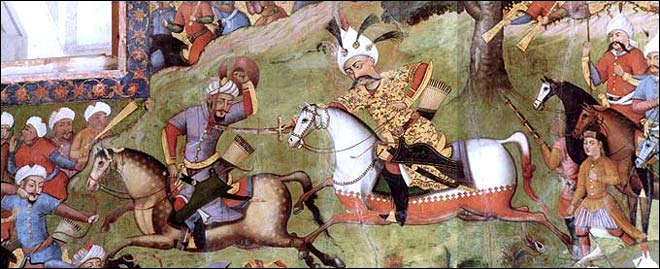
Shah Esmail killing Uzbek leader Mohammad Sheybani in a 1510 battle near Merv
The Timurid state came closest to being an integrated Iranian Empire under Timur's son Shahrokh Shah (1405-47), who endeavored to weld Azerbaijan,
which demanded three military expeditions, and western Persia to Khorasan and eastern Persia to form a united Timurid state for a short
and troubled period of time. He only succeeded in loosely controlling western and southern Iran from his beautiful capital at Herat. He made
Herat the seat of a splendid culture, the atelier of great miniature painters of Herat school,
Behzad notable among them, and the home of a
revival of Persian poetry and philosophy. This revival was not unconnected with an effort to claim for an Iranian centre once more the
leadership in the propagation of Sunni ideology; Herat used to send copies of Sunni canonical works on request to Egypt. The reaction in
Shi'ism's ultimate victory under the Safavid shahs of Persia was, however, already in preparation.
In the mean time, the "Qara Qoyunlu" (Black Sheep) Turkman, used to dominate Western Iran. In Azerbaijan they had replaced their
former masters, the Jalayirids. Timur had put these Qara Qoyunlu to run away, but in 1406 they regained their capital, Tabriz.
On Shahrokh's death, Jahan Shah (reigned c. 1438-67) extended Qara Qoyunlu rule out of the northwest deeper into Iran. The Timurids relied
on their old allies, the Qara Qoyunlus' rival Turkmans of the "Aq Qoyunlu" (White Sheep) clans,
whose Jahan Shah was destroyed by the Uzun Hasan of Aq Qoyunlu by the end of 1467.
Uzun Hasan (1453-78) achieved a short-lived Iranian Empire, but under his son Yaqub (1478-90), the state was subjected to fiscal reforms
associated with a government-sponsored effort to reapply hard purist principles of orthodox Islamic rules for revenue collection. Yaqub
attempted to purge the state of taxes introduced under the Mongols and not sanctioned by the Muslim canon. His Sunni fanaticism was discredited
by the inquiries made into his activities by the orthodox religious authorities.
The attempts to revive religious orthodoxy through revenue reform gave momentum to the spread of Safavid Shi'a propaganda. Economic decline,
which resulted from the fiscal reforms of Yaqub, must have been another factor as well.
Sheikh Jonayd's son Sheikh Heydar led a movement that had begun as a
Sufi order under his ancestor Sheikh Safi od-Din Ardabili (of Ardabil
1252-1334). This order may be considered to have originally represented a
puritanical, but not legalistically so, reaction against the corruption
of Islam, the staining of Muslim lands, by the Mongol infidels. What
began as a spiritual, unearthly reaction against irreligion and the
betrayal of spiritual aspirations developed into a manifestation of the
Shi'a quest for dominion over Islamic authority. By the 15th century,
the Safavid movement could draw on both the mystical emotional force and
the Shi'a appeal to the oppressed masses to gain a large number of
dedicated adherents. Sheikh Heydar took his numerous followers to
warfare by leading them on expeditions from Ardabil into the nearby
Caucasus. He was killed on one of these campaigns in 1488. His son
Esma'il, only one year old, was to avenge his death and lead his
devoted army to a conquest of Iran whereby Iran gained a great dynasty, a
Shi'a regime, and in most essentials its shape as a modern nation
state. Yaqub did not kill Sheikh Heydar's sons, whose mother was Yaqub's
sister, but instead sent them to exile in Fars province. The death of Yaqub
in 1490 caused turmoil and paved the path for Esmail and his brothers
to leave their exile and secretly take refuge in Lahijan, Gilan
province, as its governor had sympathy toward Shi'a.
A militant Islamic Sufi order, the Safavids, appeared among Turkish
speaking people west of the Caspian Sea, at Ardabil. The Safavid
order survived the invasion of Timur in that part of Iran in the
late 13th century. By 1500 the Safavids had adopted the Shi'a branch of
Islam and were eager to advance Shi'ism by military means. Safavid males
used to wear red headgear. They had great devotion for their leader as a
religious leader and perfect guide as well as a military chieftain, and
they viewed their leaders position as rightly passed from father to son
according to the Shi'a tradition. In the year 1500, Esma'il the
thirteen-year-old son of a killed Safavid leader, Sheikh Heydar, set out
to conquer territories and avenge the death of his father. In January 1502,
Esma'il defeated the army of Alvand Beig of Aq Qoyunlu, ruler of
Azerbaijan, and seized Tabriz and made this city his capital. Safavids
went on and conquered the rest of Azerbaijan, Armenia and Khorasan; They
became the strongest force in Iran, and their leader, Esma'il, now
fifteen, was declared Shah (King) on 11 March 1502.
In that era Iran had a variety of settled peoples; in addition to
Persians it had Kurds, Turkmans and Baluchis to name a few.
Safavid power over various tribes was not strong enough to consolidate
an absolute supremacy; tribal leaders remained those who had been
tribal chieftains and considered their tribes to be independent. However,
the Safavids laid claim to authority over all that had been Persia.
Turkish language was spoken at Shah Esma'il's court, but having adopted
Persian as the official language and much of Persian culture the Safavids
were mistakenly thought by outsiders to be Persian, but they were truly
Iranian with a unifying spirit. To help organize the state the Safavids
used Persian bureaucrats with a tradition in administration and tax
collecting, and they tried to create a religious unity. Shah Esma'il
described himself as a descendant, on his father's side, of the
Prophet Mohammad and claimed to have royal Sassanian blood as well.
Shi'ism became the state religion, Esma'il ignored the Sunni branch of
Islam and tried to force people to become Shi'a, which was a difficult
task with a variety of tribes and less than complete authority.
The newly established Iranian Empire lacked the resources that had been
available to the Islamic Caliphs of Baghdad in former times through
their dominion over Central Asia and the West in order to consolidate
their power over the Islamic authority. Asia Minor and Transoxania were
gone, and the rise of maritime trade in the West was unfavorable to a
country whose wealth had depended greatly on its position on important
east-west overland trade routes like the famous Silk Road. The rise of
the Ottomans held back Iranian westward advances and contested with the
Safavids' control over both the Caucasus and Mesopotamia. Shah Esma'il
by 1506 had conquered Iraq-e Ajam (Arak), Esfahan, Fars, Kerman,
Yazd, Kashan, Semnan, Astarabad (Gorgan) and in 1507 he added the Shi'a holy
cities of Najaf and Karbala to Iran.
In 1507 the Portuguese invaded the Persian Gulf and captured Hormuz Island. It
became a naval base and trade outpost, which lasted more than a hundred
years. Shah Esma'il, lacking a navy, reluctantly accepted this
European presence. In the mean time the Safavids extended their rule by
capturing Baghdad and Iraq in 1508. Later on, after defeating the Uzbeks
and killing their leader, Mohammad Sheybani, nicknamed Sheibak Khan, in a
battle near Merv on December 1510, Shah Esma'il absorbed the large
province of Khorasan into his state as well as Merv, Herat and Kandahar.
But the Uzbeks remained a formidable rival to the Safavid's domination of
Northern Khorasan throughout the 16th century.
The Ottoman sultan, Bayezid II, in his message congratulated Shah
Esma'il on his victories and advised him to stop destroying the graves
and mosques of Sunni Muslims. Shah Esma'il was convinced of the
righteousness of his cause and the evil of the Sunni branch of Islam; he
ignored the request. With many Shi'a Muslims in Asia Minor under the
authority of the Ottoman sultan, Bayezid II was concerned about the
power of the Safavids. The new sultan in Constantinople after 1512,
Sultan Selim, warred against Shi'a Muslims under his rule, killing
thousands and relocating others. Sultan Selim waged war also against the
Safavids. On 23 August 1514, just west of Tabriz in the Chalderan plain,
Shah Esma'il's army suffered a crushing defeat. Its cavalry and
infantry were armed with spears, bows and swords, fighting against
the Ottoman's superior numbers as well as field artillery and musketeers.
Shah Esma'il and his followers firmly believed that Allah was on their
side, but they were confused by their military setback, Tabriz, their
capital was briefly occupied. This battle and defeat of Safavid Shah
paved the path for the Ottoman conquest of Diyarbakr, Erzinjan, and
other parts of eastern Anatolia as well as northern Iraq. Shah Esma'il
himself found relief from psychological depression in wine, and died ten
years later, at the age of thirty-seven.
Shah Esma'il's descendants Shah Tahmasp I (1524-1576), Shah Esma'il II
(1576-1577) and Shah Mohammad (1577-1587), ruling in succession,
recovered some of the original Safavid confidence and expanded in the
opposite direction of the Ottomans, as far as Transoxiana. Safavid shahs
tightened their controls over Iran; each district had its own Safavid
leader, a "Qezelbash" chief, answerable to the shah. In time of
war the Qezelbash chiefs were responsible for providing soldiers for
the shah's army and collecting revenues to pay for war. The local
Qezelbash chiefs grew wealthy in land and in collecting taxes. Shah
Tahmasp I, the eldest son of Shah Esma'il, ascended the throne at the age
of ten, and for the first ten years of his reign, real power was held by
a number of leaders of competing Qezelbash factions, which caused much
political instability. In 1533 Shah Tahmasp I asserted his authority.
One of his legacies was the introduction of converted slaves into court
and the military. They were drawn from thousands of Georgian, Circassian
and Armenian prisoners captured in campaigns fought in the Caucasus in
the 1540s and 1550s. Female slaves entered the royal harem, becoming
mothers of princes and a force in court politics and dynastic quarrels.
Some of the male slaves began to acquire positions of influence, under
Shah Abbas I, reaching high offices that challenged the supremacy of the Qezelbash.
During the reign of Shah Tahmasp I, the Uzbeks launched as many as five
major invasions of Khorasan with the intent of retaking the area.
The Safavids were successful in driving back the Uzbek threat; and in 1545
they captured Kandahar from the Mughal Empire. The Safavid capital
was moved to Qazvin in 1548, following the temporary capture of Tabriz
by the Ottomans. Despite periodic wars between Iran and the Ottoman
Empire, they maintained an extensive trade, especially in the highly
prized Iranian silk. Large quantities of silk were shipped from
Iran to commercial centres such as Aleppo and Bursa and from there
re-exported to Marseilles, London, and Venice.
Shah Tahmasp I encouraged carpet weaving on the scale of a state
industry. The exquisite miniatures illustrating the Iranian national
epic known as the "Shahnama" (Epic of Kings) were painted at the request
of Shah Tahmasp. This masterpiece is known as "Shahnameh of Tahmaspi"
and was presented by the Safavid ruler to the Ottoman sultan Selim II in 1568.
In 1576 the Qezelbash faction interested in a prince whose mother was
Turkman rather than Circassian or Georgian, brought Shah Esma'il II, son
of Shah Tahmasp I, to power. Shah Esma'il II's reign was marked by
brutality and a pro-Sunni policy. Consequently in November 1577, he was
poisoned with the participation of his sister Pari Khan Khanom.
Mohammad Shah, the only surviving brother of Shah Esma'il II, proved
to be a weak leader. His wife Mahd-e Olya initially dominated him; but
after her assassination in 1579 the Qezelbash took control. Meanwhile
the Ottomans took advantage of Iran's political turmoil to launch a major
invasion of the country. Consequently extensive territories were lost to
the Ottomans, including most of Azerbaijan, with Tabriz, and Georgia.
With their self-esteem and power derived from their increased wealth,
some local Qezelbash chiefs wished to have more freedom from the shah's
authority. They tried to convince Mohammad Shah that he should select a
successor agreeable to them. Some of these chiefs tried to reduce the
chances of another choice by executing the heir apparent, his mother and
some other possible heirs within the royal family. As often happens,
politics by murder was less than efficient. The younger brother of the
murdered heir apparent was secretly sent away to Khorasan, and Qezelbash
chiefs loyal to the royal family fought and defeated Qezelbash chiefs
who were not, and full power was returned to the old dynasty of shahs.
Abbas I (1587-1629), who succeeded Mohammad Shah, learnt from his
family's experience with the local Qezelbash chiefs, and he broke their
power and confiscated their wealth. He extended state-owned lands and
lands owned by the shah. Provinces were now to be administered by the
state replacing the Qezelbash chiefs. He strengthened his government's
bureaucracy and managed to relocate tribes in order to weaken their
power. The Sufi bands, Qezelbash, which had been formed into artificial
tribal units mainly for military purposes during the dynasty's formative
period, as a source of recruitment, were replaced by a standing strong
army of his own. He recruited soldiers from Persian villages and from
among Christians, Georgians, Circassians, Armenians and others, equipped
them with artillery and muskets. The Christians were proud to serve the
shah and to call themselves "Ghulams" (slaves) of the shah
although slaves they were not. To finance the new army, Shah Abbas
converted large pieces of land traditionally granted to tribal chiefs as
assignments into crown lands that he taxed directly. This new military
force was trained on European lines with the advice of Robert Sherley.
Sherley was an English adventurer expert in artillery tactics who,
accompanied by a party of cannon founders, reached Qazvin with his
brother Anthony Sherley in 1598. In a short time Shah Abbas created a
formidable army, consisting of cavalry, infantry and artillery.
Shah Abbas was open to ideas and was mentally active as well. He was
curious and in ways more tolerant than his predecessors. Previously,
"infidels" (foreigners and non-Muslim subjects) had been denied entry to
the shah's court. He welcomed foreigners and his non-Muslims subjects
to his court, and enjoyed discussing with foreigners the complexities of
religious ideology. He took an unusual step among Islamic rulers by
allowing Christians to wear what they wanted and allowing them to own
their own home and land.
Shah Abbas defeated the Uzbeks in April 1598 and recovered Herat and territories in Khorasan, including Mashhad,
lost several years earlier. He strongly consolidated Safavid power in Khorasan. He rebuilt and developed the shrine of Ali ar-Reza (Imam Reza)
at Mashhad, the eighth Shi'a Imam, as a pilgrim, which was damaged by the Uzbeks. The shrine became a major centre for Shi'a pilgrimage,
and a rival to Shi'a holy places in Mesopotamia, like Najaf and Karbala, where visiting pilgrims took currency and attention out of Safavid into Ottoman territory.
The Safavids had earlier moved their capital from the vulnerable Tabriz to Qazvin. Since the Uzbek threat from east of the Caspian had been
overcome, Shah Abbas could move to his newly built capital at Esfahan in 1598, more centrally placed than Qazvin for control over the whole
country and for communication with the trade outlets of the Persian Gulf.

Ali Qapou Palace in Shah Square, Esfahan
Under Shah Abbas I, Iran prospered; he also transplanted a colony of
industrious and commercially astute Armenians from Jolfa in Azerbaijan
to a new Jolfa next to Esfahan. He patronized the arts, and he built
palaces, mosques and schools, Esfahan becoming the cultural and
intellectual capital of Iran. Shah Abbas encouraged international trade
and the production of silks, carpets, ceramics and metal ware for sale
to Europeans. Shah Abbas also founded a carpet factory in Esfahan.
Royal patronage and the influence of court designers assured that
Persian carpets reached their zenith in elegance during the Safavid
period. He advanced trade by building and safeguarding roads. He
welcomed tradesmen from Britain, the Netherlands and elsewhere to Iran.
His governmental monopoly over the silk trade enhanced state revenues.
Merchants of the English East India Company established trading houses
in Shiraz and Esfahan. After Shah Abbas ousted the Portuguese from the
island of Hormuz at the entrance to the Persian Gulf in 1622, Bandar
Abbas (Port of Abbas) became the centre of the East India Company's
trade. But Later the Dutch East India Company received trade
capitulations from Shah Abbas. The Dutch soon gained supremacy in the
European trade with Iran, outdistancing British competitors. They
established a spice-trading centre at Bandar Abbas. In 1623-24 Shah
Abbas I launched an offensive against the Ottomans and established control
over Kurdish territories, Baghdad and the Shi'a Holy Cities of Najaf and Karbala.
During his reign, Shah Abbas I paid considerable attention to the
welfare institutions in Esfahan and other cities like establishing
hospitals. Medical practice was still depended on medieval guides for
the treatment of most illnesses. The standard reference work remained
the Canon of Ebn Sina (Avicenna) (d. 1037), but new clinical works were
written during the Safavid period as well. In the 17th century, a
unique work, The Treasury of Surgery, was written by an army surgeon
known as Hakim Mohammad and was dedicated to Shah Safi I. It included a
detailed list of the instruments available to surgeons, including a
special device for the removal of bullets; outlined various forms of
anesthesia; and advocated surgery for cancerous tumors.
The bureaucracy, too, was carefully reorganized, bold reforms in the
military, administrative, and fiscal structures helped to centralize
state authority to a degree not achieved by Shah Abbas I predecessors.
But the seeds of the sovereignty's weakness lay in the royal house
itself, which lacked an established system of inheritance by
primogeniture. One of Shah Abbas I innovations, however, weakened the
Safavid state in the long run; fear of revolts by his sons led him to
abandon the traditional practice of employing the princes to govern
provinces. Instead, he instituted the practice of confinement of infant
princes in the palace gardens away from the direct reach of conspiracies
and the world at large. A reigning shah's nearest and most acute
objects of suspicion were his own sons. Among them, brother plotted
against brother over who should succeed on their father's death; and
conspirator, ambitious for influence in a subsequent reign, supported
one prince against another. The new practice, followed also by his
successors, resulted in ill-educated, indecisive shahs of lower
competence, easily dominated by powerful religious dignitaries to whom
the Safavids had accorded considerable influence in an attempt to make
Shi'ism the state religion
After Shah Abbas I death in 1629, his son Shah Safi I, who ruled from
1629 to 1642, is known for his cruelty, sat on the throne. He was the
first of the Safavid shahs to be raised in the palace gardens. Shah Safi
I put to death potential rivals to the throne as well as some of his
male and female relatives on his accession. He executed most of the
generals, officers and councilors he had inherited from his father's
reign. The dominant influence of Mirza Taqi, known as Saru Taqi, the
Grand Vezir (chancellor) at the Safavid court allowed the government to
be run smoothly despite the shah's lack of interest in affairs of state.
On 17 may 1639, peace treaty with the Ottomans, which established the
Ottoman-Safavid frontier and put an end to more than a hundred years of
sporadic conflict. The treaty forced Shah Safi I to accept the final
loss of Baghdad in Mesopotamia, recaptured by the Ottomans in 1638, and
instead gave Yerevan in the southern Caucasus to Iran.
Era of Shah Abbas II, who ruled from 1642 to 1667, was the last fully
competent period of rule by a Safavid shah. Shah Abbas II took an active
role in government matters. Under his rule Iran revived, and some of
Persia's glory in the eyes of the outside world returned. He increased
the central authority of the state by increasing crown lands and often
intervened in provincial affairs on the side of the peasants, but with
peace on the frontiers the army declined in size and quality. He stuck
to the notion that the Safavid ruler was sacred and perfect, and
disputed openly with members of the Shi'a religious establishment who
had begun to articulate the idea that in the absence of the hidden Imam
Zaman (twelfth Shi'a Imam), true temporal authority rightly belonged to
the mojtahid (similar to the position to be known as ayatollah), who
merited emulation by the faithful. Safavid Shi'ism had not improved
monarchy as an institution, but instead recognized the state as a
theocracy. The olama, religious leaders rebuked the shahs, questioned
the religious legitimacy of their power and claimed that the mojtahids
has a superior claim to rule.
After Abbas II died in 1667, decline set in again when Shah Soleyman
(Safi II), who ruled from 1667 to 1694, took power. He was renamed,
superstitiously, to Soleyman because the first year and half of his
reign was so disastrous. Shah Soleyman was not a competent ruler, and
shortly after his accession food prices soared and famine and disease
spread throughout the country. Although pressing problems faced him, he
increasingly retreated into the harem and left his grand vezir to cope
with affairs of state.
Shah Sultan Hossein, who ruled from 1694 to 1722, have been described as
the most incompetent shah of Safavids. He was similar to some others
who had inherited power by accident of birth. Indifferent to affairs of
state, Shah Sultan Hossein effectively brought Safavid Empire to its
sudden and unexpected end. He was of a religious temperament and
especially influenced by the Shi'a religious establishment. At their
insistence, he issued decrees forbidding the consumption of alcohol and
banning Sufism in Esfahan. In 1694 Shah Sultan Hossein appointed
Mohammad Baqir Majlesi, the most influential member of Shi'a religious
establishment, to the new office of "Mulla Bashi" (Head Mulla).
Majlesi wrote "Bihar al-Anwar" (The Seas of Light), an encyclopedic
work dedicated to the preservation of the prophet Mohammad's words and
deeds. He devoted himself to the propagation of a legalistic form of
Shi'ism and to the eradication of Sufism and Sunni Islam in Iran. Under
his guidance specifically Shi'a popular rituals, such as mourning for
the martyred third Shi'a Imam Hossein (d. 680), Ashora, were encouraged,
as were pilgrimages to the tombs of holy Shi'a personages. Majlesi's
policies also included the persecution of non-Muslims in Iran, including
Zoroastrians, Jews, and Christians. Unchecked by the Safavid regime,
Majlesi and the Shi'a clergy emerged with increased strength and
independence from the ruling government in the 17th and 18th centuries.
Safavid Empire had also declined militarily, leaving it more vulnerable
to invasion, which came out of the east. In 1722 Afghan invaders under
Mahmoud, a former Safavid vassal in Afghanistan, captured Esfahan and
murdered Shah Sultan Hossein. The Afghan invasion was disastrous for
Iran, which consequently in 1723 the Ottomans took advantage of the
disintegration of the Safavid realm and invaded from the west, ravaging
western Persia as far as Hamadan, while the Russians seized territories
around the Caspian Sea. In June 1724 the two powers agreed on a peaceful
partitioning of Iran's northwestern provinces.
Nader Khan (Nader Qoli), an able general from the Turkman tribe of
Afshar, from northern Khorasan, assembled an army and began the
reconsolidation of the country under his control. He effectively became
ruler of Iran, although he acknowledged the Sultan Hossein's son,
Tahmasp II, who had escaped the Afghans, as Safavid shah until 1732,
then Tahmasp's infant son Abbas III until 1736, at which time he
declared himself shah. Nader expelled the Afghans by 1730 and cleared
the country of them; regained control over the northwestern provinces of
Iran from the hands of Ottomans in 1730; and had the lands occupied by
the Russians restored in 1735.
Safavid Kings:
1502 - 1524 : Ismail I
1524 - 1576 : Tahmasp
1576 - 1577 : Ismail II
1577 - 1587 : Mohammad
1587 - 1629 : Abbas I, The Great
1629 - 1642 : Safi I
1642 - 1667 : Abbas II
1667 - 1694 : Safi II
1694 - 1722 : Soltan Hossein
1722 - 1732 : Tahmasp II
1732 - 1736 : Abbas III
|
(Iranian Army reconstructions, 1971)
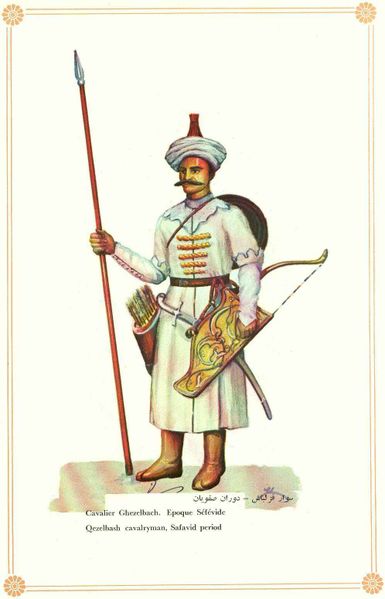
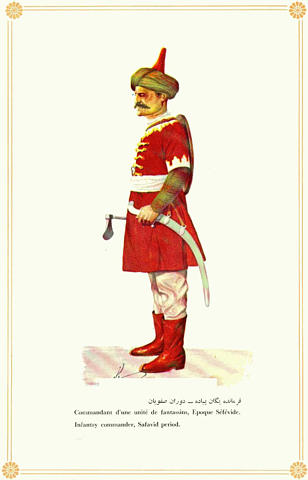
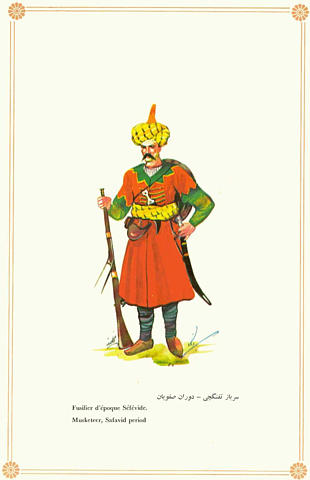
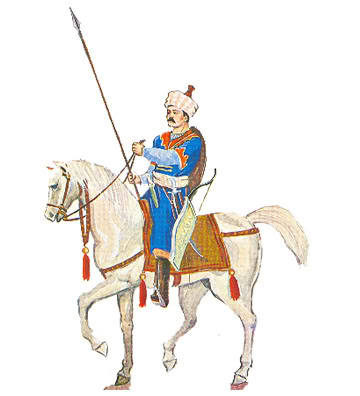
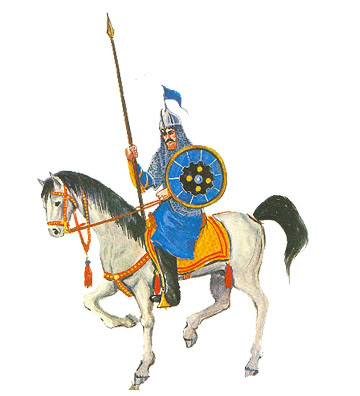
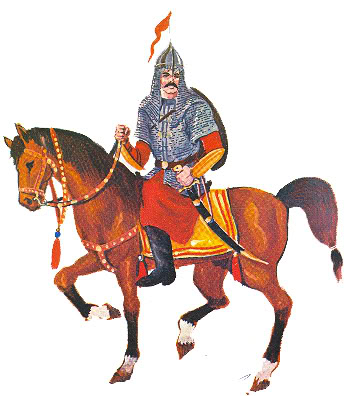
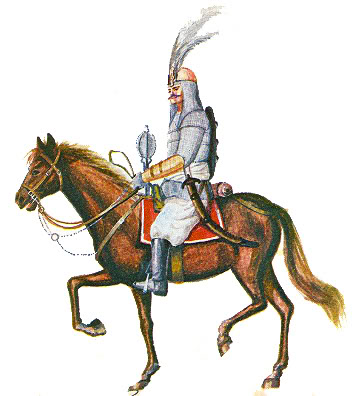
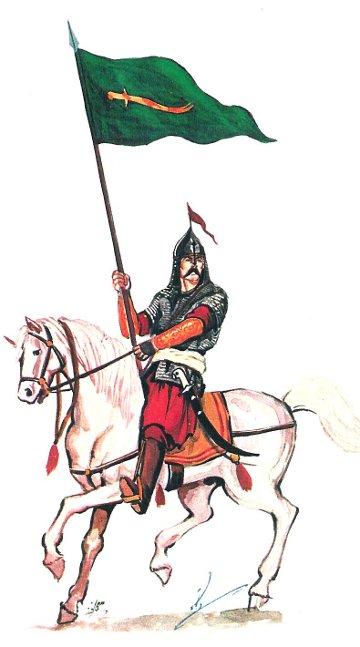
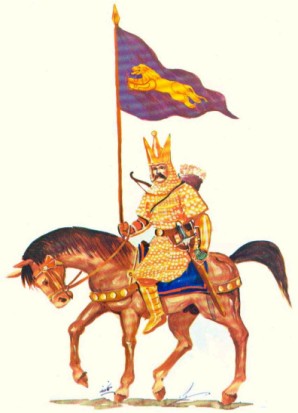
|



















